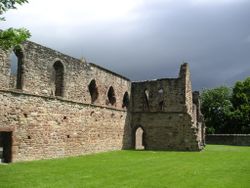Beauly
| Beauly Gaelic: A' Mhanachainn | |
| Inverness-shire | |
|---|---|
 Beauly Priory | |
| Location | |
| Grid reference: | NH525465 |
| Location: | 57°29’5"N, 4°27’43"W |
| Data | |
| Population: | 1,164 |
| Post town: | Beauly |
| Postcode: | IV4 |
| Local Government | |
| Council: | Highland |
Beauly is a town in the north of mainland Inverness-shire close to the border with Ross-shire. It is situated on the River Beauly, ten miles west of the county town Inverness by the Far North railway line. The town's name comes from the French Beaulieu meaning 'beautiful place'.
The land around Beauly is fertile and the town historically traded in coal, timber, lime, grain and fish.[1]
Early years
Beauly is the site of the Beauly Priory, or the Priory Church of the Blessed Virgin and John the Baptist, founded in 1230 by John Byset of the Aird, for Valliscaulian monks. Following the Reformation, the buildings (except the church, now a ruin) passed into the possession of Lord Lovat.
Beauly is also the site of Lovat Castle, which once belonged to the Bissets, but was presented by James VI, to Hugh Fraser, 5th Lord Lovat and later demolished.[1]
Recent history
In 1994 Simon Fraser, 15th Lord Lovat sold the castle to Ann Gloag of the Stagecoach Group to pay off debts. In 2002, the Beauly railway station, built in 1862 and closed in 1960, was renovated and reopened.
Other attractions
The town is known for the Beauly Shinty Club, who have won the Camanachd Cup three times and have been World Champions once.
To the south-east of Beauly is the church of Kirkhill containing the vault of the Lovats as well as a number of septs of the Mackenzies, including Seaforth and Mackenzies of Gairloch.
Three miles south of Beauly is Beaufort Castle, the chief seat of the Lovats, a modern mansion in the Scottish baronial style. It occupies the site of a fortress erected in the time of Alexander II, which was besieged in 1303 by Edward I. This was replaced by several castles in succession, of which one, Castle Dounie, was taken by Oliver Cromwell and burned by Prince William, Duke of Cumberland in 1746, the conflagration being witnessed from a neighbouring hill by Simon Fraser, 11th Lord Lovat, before his capture on Loch Morar.[1]
References
Outside links
- Visit Beauly from the Beauly Marketing Group